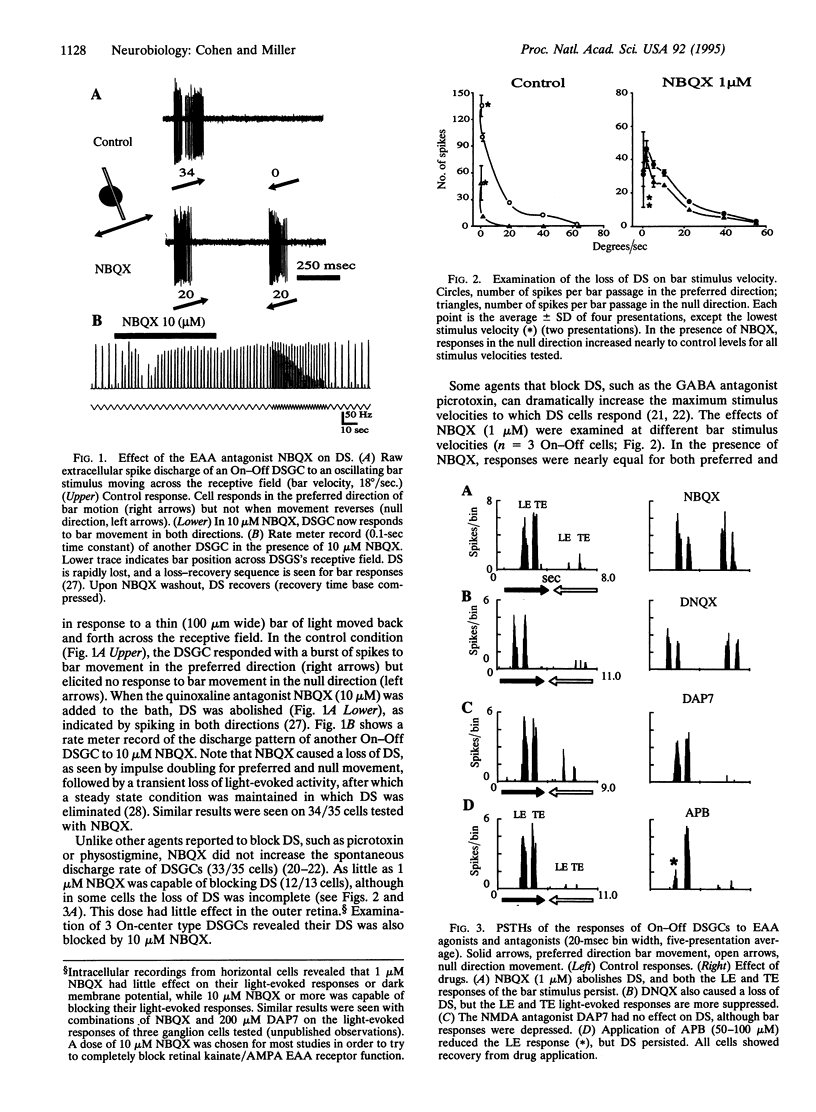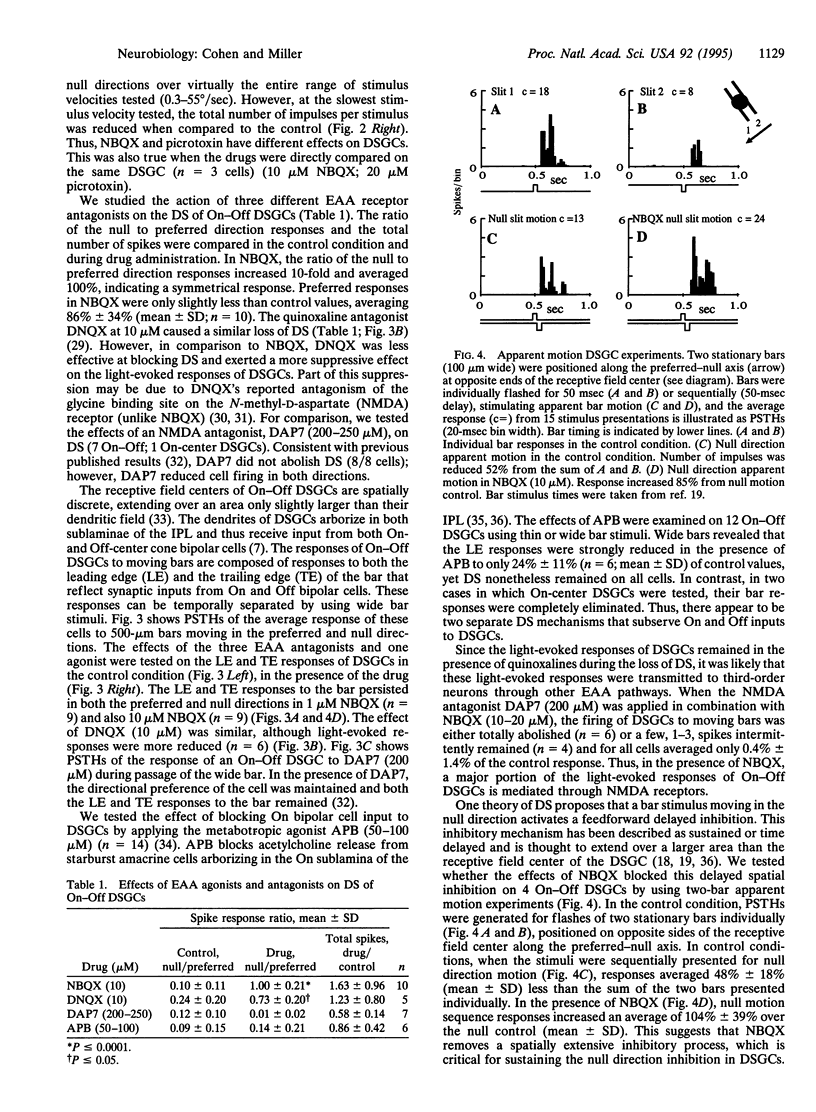Abstract
Direction selectivity is a receptive field property displayed by neurons throughout the visual system. Previous experiments have concentrated on the role of lateral connections that use gamma-aminobutyric acid and acetylcholine. We have examined the role of excitatory amino acid receptors on direction-selective ganglion cell function in the rabbit retina. Application of the quinoxalines, a group of kainate/alpha-amino-3-hydroxy-5-methyl-4-isoxazolepropionic acid receptor antagonists, selectively blocked the directional-selectivity mechanism, leaving cells responsive to both directions of movement. In contrast, direction selectivity was unaffected by N-methyl-D-aspartate receptor antagonists or L-2-amino-4-phosphonobutyric acid. Large reductions in acetylcholine release by starburst amacrine cells appear to parallel losses of direction selectivity observed in the quinoxalines. These results shed additional insights into the mechanism of direction selectivity.
Full text
PDF




Selected References
These references are in PubMed. This may not be the complete list of references from this article.
- Ames A., 3rd, Nesbett F. B. In vitro retina as an experimental model of the central nervous system. J Neurochem. 1981 Oct;37(4):867–877. doi: 10.1111/j.1471-4159.1981.tb04473.x. [DOI] [PubMed] [Google Scholar]
- Amthor F. R., Oyster C. W., Takahashi E. S. Morphology of on-off direction-selective ganglion cells in the rabbit retina. Brain Res. 1984 Apr 23;298(1):187–190. doi: 10.1016/0006-8993(84)91167-3. [DOI] [PubMed] [Google Scholar]
- Ariel M., Daw N. W. Pharmacological analysis of directionally sensitive rabbit retinal ganglion cells. J Physiol. 1982 Mar;324:161–185. doi: 10.1113/jphysiol.1982.sp014105. [DOI] [PMC free article] [PubMed] [Google Scholar]
- BARLOW H. B., HILL R. M., LEVICK W. R. RETINAL GANGLION CELLS RESPONDING SELECTIVELY TO DIRECTION AND SPEED OF IMAGE MOTION IN THE RABBIT. J Physiol. 1964 Oct;173:377–407. doi: 10.1113/jphysiol.1964.sp007463. [DOI] [PMC free article] [PubMed] [Google Scholar]
- BARLOW H. B., HILL R. M. Selective sensitivity to direction of movement in ganglion cells of the rabbit retina. Science. 1963 Feb 1;139(3553):412–414. doi: 10.1126/science.139.3553.412. [DOI] [PubMed] [Google Scholar]
- Barlow H. B., Levick W. R. The mechanism of directionally selective units in rabbit's retina. J Physiol. 1965 Jun;178(3):477–504. doi: 10.1113/jphysiol.1965.sp007638. [DOI] [PMC free article] [PubMed] [Google Scholar]
- Birch P. J., Grossman C. J., Hayes A. G. Kynurenate and FG9041 have both competitive and non-competitive antagonist actions at excitatory amino acid receptors. Eur J Pharmacol. 1988 Jul 7;151(2):313–315. doi: 10.1016/0014-2999(88)90814-x. [DOI] [PubMed] [Google Scholar]
- Bloomfield S. A., Miller R. F. A functional organization of ON and OFF pathways in the rabbit retina. J Neurosci. 1986 Jan;6(1):1–13. doi: 10.1523/JNEUROSCI.06-01-00001.1986. [DOI] [PMC free article] [PubMed] [Google Scholar]
- Brecha N., Johnson D., Peichl L., Wässle H. Cholinergic amacrine cells of the rabbit retina contain glutamate decarboxylase and gamma-aminobutyrate immunoreactivity. Proc Natl Acad Sci U S A. 1988 Aug;85(16):6187–6191. doi: 10.1073/pnas.85.16.6187. [DOI] [PMC free article] [PubMed] [Google Scholar]
- Buhl E. H., Peichl L. Morphology of rabbit retinal ganglion cells projecting to the medial terminal nucleus of the accessory optic system. J Comp Neurol. 1986 Nov 8;253(2):163–174. doi: 10.1002/cne.902530204. [DOI] [PubMed] [Google Scholar]
- Caldwell J. H., Daw N. W., Wyatt H. J. Effects of picrotoxin and strychnine on rabbit retinal ganglion cells: lateral interactions for cells with more complex receptive fields. J Physiol. 1978 Mar;276:277–298. doi: 10.1113/jphysiol.1978.sp012233. [DOI] [PMC free article] [PubMed] [Google Scholar]
- Cohen E. D., Miller R. F. The role of NMDA and non-NMDA excitatory amino acid receptors in the functional organization of primate retinal ganglion cells. Vis Neurosci. 1994 Mar-Apr;11(2):317–332. doi: 10.1017/s0952523800001668. [DOI] [PubMed] [Google Scholar]
- Dixon D. B., Copenhagen D. R. Two types of glutamate receptors differentially excite amacrine cells in the tiger salamander retina. J Physiol. 1992 Apr;449:589–606. doi: 10.1113/jphysiol.1992.sp019103. [DOI] [PMC free article] [PubMed] [Google Scholar]
- Downing J. E., Kaneko A. Cat retinal ganglion cells show transient responses to acetylcholine and sustained responses to L-glutamate. Neurosci Lett. 1992 Mar 16;137(1):114–118. doi: 10.1016/0304-3940(92)90311-t. [DOI] [PubMed] [Google Scholar]
- Famiglietti E. V. Dendritic co-stratification of ON and ON-OFF directionally selective ganglion cells with starburst amacrine cells in rabbit retina. J Comp Neurol. 1992 Oct 15;324(3):322–335. doi: 10.1002/cne.903240303. [DOI] [PubMed] [Google Scholar]
- Famiglietti E. V., Jr 'Starburst' amacrine cells and cholinergic neurons: mirror-symmetric on and off amacrine cells of rabbit retina. Brain Res. 1983 Feb 14;261(1):138–144. doi: 10.1016/0006-8993(83)91293-3. [DOI] [PubMed] [Google Scholar]
- Famiglietti E. V., Jr On and off pathways through amacrine cells in mammalian retina: the synaptic connections of "starburst" amacrine cells. Vision Res. 1983;23(11):1265–1279. doi: 10.1016/0042-6989(83)90102-5. [DOI] [PubMed] [Google Scholar]
- Famiglietti E. V. Starburst amacrine cells in cat retina are associated with bistratified, presumed directionally selective, ganglion cells. Brain Res. 1987 Jun 16;413(2):404–408. doi: 10.1016/0006-8993(87)91038-9. [DOI] [PubMed] [Google Scholar]
- Honoré T., Davies S. N., Drejer J., Fletcher E. J., Jacobsen P., Lodge D., Nielsen F. E. Quinoxalinediones: potent competitive non-NMDA glutamate receptor antagonists. Science. 1988 Aug 5;241(4866):701–703. doi: 10.1126/science.2899909. [DOI] [PubMed] [Google Scholar]
- Kessler M., Baudry M., Lynch G. Quinoxaline derivatives are high-affinity antagonists of the NMDA receptor-associated glycine sites. Brain Res. 1989 Jun 12;489(2):377–382. doi: 10.1016/0006-8993(89)90875-5. [DOI] [PubMed] [Google Scholar]
- Levick W. R. Another tungsten microelectrode. Med Biol Eng. 1972 Jul;10(4):510–515. doi: 10.1007/BF02474199. [DOI] [PubMed] [Google Scholar]
- Linn D. M., Massey S. C. Acetylcholine release from the rabbit retina mediated by NMDA receptors. J Neurosci. 1991 Jan;11(1):123–133. doi: 10.1523/JNEUROSCI.11-01-00123.1991. [DOI] [PMC free article] [PubMed] [Google Scholar]
- Lipton S. A., Aizenman E., Loring R. H. Neural nicotinic acetylcholine responses in solitary mammalian retinal ganglion cells. Pflugers Arch. 1987 Sep;410(1-2):37–43. doi: 10.1007/BF00581893. [DOI] [PubMed] [Google Scholar]
- Masland R. H., Ames A., 3rd Responses to acetylcholine of ganglion cells in an isolated mammalian retina. J Neurophysiol. 1976 Nov;39(6):1220–1235. doi: 10.1152/jn.1976.39.6.1220. [DOI] [PubMed] [Google Scholar]
- Masland R. H., Mills J. W. Autoradiographic identification of acetylcholine in the rabbit retina. J Cell Biol. 1979 Oct;83(1):159–178. doi: 10.1083/jcb.83.1.159. [DOI] [PMC free article] [PubMed] [Google Scholar]
- Masland R. H., Mills J. W., Cassidy C. The functions of acetylcholine in the rabbit retina. Proc R Soc Lond B Biol Sci. 1984 Nov 22;223(1230):121–139. doi: 10.1098/rspb.1984.0086. [DOI] [PubMed] [Google Scholar]
- Masland R. H., Mills J. W., Cassidy C. The functions of acetylcholine in the rabbit retina. Proc R Soc Lond B Biol Sci. 1984 Nov 22;223(1230):121–139. doi: 10.1098/rspb.1984.0086. [DOI] [PubMed] [Google Scholar]
- Massey S. C., Miller R. F. N-methyl-D-aspartate receptors of ganglion cells in rabbit retina. J Neurophysiol. 1990 Jan;63(1):16–30. doi: 10.1152/jn.1990.63.1.16. [DOI] [PubMed] [Google Scholar]
- Massey S. C., Redburn D. A. The cholinergic amacrine cells of rabbit retina receive on and off input: an analysis of [3H]-ACh release using 2-amino-4-phosphonobutyric acid (APB) and chloride free medium. Vision Res. 1983;23(12):1615–1620. doi: 10.1016/0042-6989(83)90175-x. [DOI] [PubMed] [Google Scholar]
- Miller R. F., Zalutsky R. A., Massey S. C. A perfused rabbit retina preparation suitable for pharmacological studies. J Neurosci Methods. 1986 Jun;16(4):309–322. doi: 10.1016/0165-0270(86)90056-7. [DOI] [PubMed] [Google Scholar]
- Oyster C. W. The analysis of image motion by the rabbit retina. J Physiol. 1968 Dec;199(3):613–635. doi: 10.1113/jphysiol.1968.sp008671. [DOI] [PMC free article] [PubMed] [Google Scholar]
- Pu M. L., Amthor F. R. Dendritic morphologies of retinal ganglion cells projecting to the lateral geniculate nucleus in the rabbit. J Comp Neurol. 1990 Dec 15;302(3):675–693. doi: 10.1002/cne.903020320. [DOI] [PubMed] [Google Scholar]
- Pu M. L., Amthor F. R. Dendritic morphologies of retinal ganglion cells projecting to the nucleus of the optic tract in the rabbit. J Comp Neurol. 1990 Dec 15;302(3):657–674. doi: 10.1002/cne.903020319. [DOI] [PubMed] [Google Scholar]
- Sheardown M. J., Nielsen E. O., Hansen A. J., Jacobsen P., Honoré T. 2,3-Dihydroxy-6-nitro-7-sulfamoyl-benzo(F)quinoxaline: a neuroprotectant for cerebral ischemia. Science. 1990 Feb 2;247(4942):571–574. doi: 10.1126/science.2154034. [DOI] [PubMed] [Google Scholar]
- Slaughter M. M., Miller R. F. 2-amino-4-phosphonobutyric acid: a new pharmacological tool for retina research. Science. 1981 Jan 9;211(4478):182–185. doi: 10.1126/science.6255566. [DOI] [PubMed] [Google Scholar]
- Vaney D. I., Young H. M. GABA-like immunoreactivity in cholinergic amacrine cells of the rabbit retina. Brain Res. 1988 Jan 12;438(1-2):369–373. doi: 10.1016/0006-8993(88)91366-2. [DOI] [PubMed] [Google Scholar]
- Wyatt H. J., Daw N. W. Directionally sensitive ganglion cells in the rabbit retina: specificity for stimulus direction, size, and speed. J Neurophysiol. 1975 May;38(3):613–626. doi: 10.1152/jn.1975.38.3.613. [DOI] [PubMed] [Google Scholar]
- Wyatt H. J., Day N. W. Specific effects of neurotransmitter antagonists on ganglion cells in rabbit retina. Science. 1976 Jan 16;191(4223):204–205. doi: 10.1126/science.1857. [DOI] [PubMed] [Google Scholar]
- Yang G., Masland R. H. Direct visualization of the dendritic and receptive fields of directionally selective retinal ganglion cells. Science. 1992 Dec 18;258(5090):1949–1952. doi: 10.1126/science.1470920. [DOI] [PubMed] [Google Scholar]
- Yazejian B., Fain G. L. Whole-cell currents activated at nicotinic acetylcholine receptors on ganglion cells isolated from goldfish retina. Vis Neurosci. 1993 Mar-Apr;10(2):353–361. doi: 10.1017/s0952523800003746. [DOI] [PubMed] [Google Scholar]


